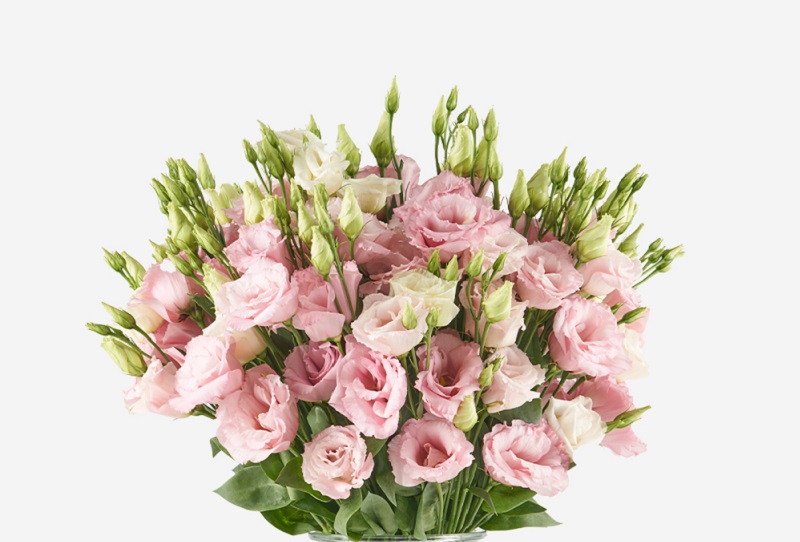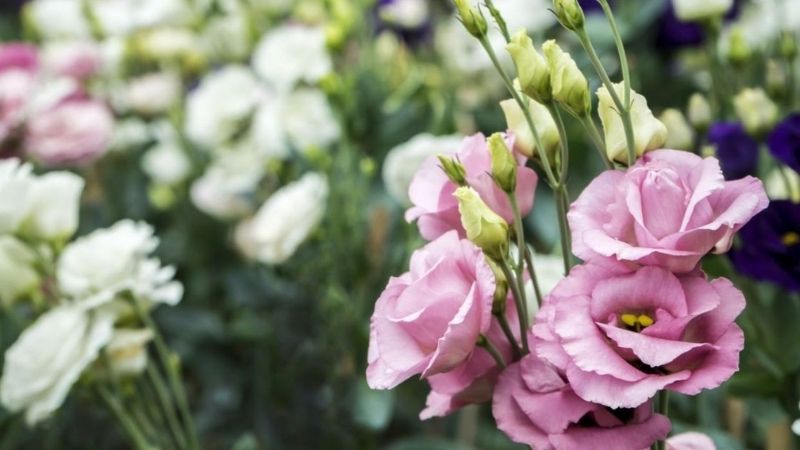Pink lisianthus, with its delicate petals and soft hues, stands out as one of the most beloved flowers in floral arrangements and garden settings. Known for its elegant appearance and versatility, pink lisianthus adds a touch of romance and sophistication to any occasion. This article explores the defining features, history, cultivation practices, and cultural significance of pink lisianthus, offering insights into why this flower remains a popular choice for both gardeners and florists.
Definition and Characteristics
What is Pink Lisianthus?
Pink lisianthus, scientifically known as Eustoma grandiflorum, is a flowering plant prized for its stunning blooms and refined aesthetic. Often referred to as the “prairie gentian,” it is native to the southern United States and Mexico. The pink variety is especially popular due to its gentle, romantic color, making it a favorite for weddings, special events, and floral arrangements.

Unique Features of Pink Lisianthus
Pink lisianthus is characterized by its large, ruffled blooms that resemble roses or peonies. The flowers come in various shades of pink, from soft pastels to vibrant hues. The plant’s growth habit is typically upright, with slender stems that support the elegant blossoms. The foliage is green and lance-shaped, providing a subtle backdrop to the flower’s striking appearance.
History and Origin
Historical Background of Lisianthus
Lisianthus has a rich history, with its cultivation dating back to the 19th century. Native to the American prairies, it was introduced to European horticulture by plant explorers and quickly gained popularity for its beauty and adaptability. Early cultivation focused on breeding varieties with enhanced flower size and color.
Evolution of Pink Lisianthus
The development of pink lisianthus is a testament to advancements in horticultural breeding. The pink variety emerged as breeders sought to expand the color palette of lisianthus, resulting in a range of pink shades that cater to different aesthetic preferences. Its introduction into the floral market revolutionized floral design, adding a new level of elegance and versatility.
Botanical Characteristics
Physical Appearance
Pink lisianthus features large, showy flowers that can measure up to 3 inches in diameter. The blooms are typically ruffled or frilled, with multiple layers of petals that create a lush, full appearance. The plant itself grows to a height of 12 to 18 inches, with a compact and bushy form.
Growth Habits
Pink lisianthus has a relatively slow growth cycle, with blooms typically appearing 4 to 6 months after planting. The plant prefers cooler temperatures and can be grown as an annual or biennial, depending on the climate. It produces multiple stems with clusters of flowers, making it an excellent choice for creating full and impressive floral arrangements.
Environmental Needs
Pink lisianthus thrives in well-drained soil with a slightly acidic to neutral pH. It requires full sun to partial shade and benefits from regular watering to keep the soil consistently moist but not waterlogged. The plant is sensitive to frost, so it is best suited for climates with mild winters or grown as an indoor plant in colder regions.
Cultivation
Climate and Soil Requirements
Pink lisianthus prefers a temperate climate with moderate temperatures. It thrives in well-drained soil enriched with organic matter. Soil preparation should include compost or well-rotted manure to improve fertility and drainage. Adequate sunlight is essential for optimal growth, with a minimum of 6 hours of direct light per day.
Planting Techniques
Plant pink lisianthus seeds or seedlings in the spring after the last frost. Space plants about 8 to 12 inches apart to allow for their mature size and ensure good air circulation. For best results, sow seeds indoors 8 to 10 weeks before the last expected frost, or direct-seed outdoors once the soil has warmed.
Care and Maintenance
Regular watering is crucial, especially during dry periods, but avoid overwatering to prevent root rot. Fertilize every 4 to 6 weeks with a balanced, water-soluble fertilizer to support healthy growth and blooming. Deadhead spent flowers to encourage continuous blooming and reduce the risk of disease. Monitor for pests such as aphids and spider mites, and apply appropriate treatments as needed.

Popular Varieties
Overview of Notable Pink Lisianthus Varieties
- ‘Café Latte Pink’: Features soft, blush pink blooms with a creamy, elegant appearance.
- ‘Rosita Pink’: Known for its vibrant, rosy pink flowers that add a bold touch to arrangements.
- ‘Echo Pink’: Offers a pale, pastel pink color with a subtle, delicate fragrance.
Pests and Diseases
Common Issues Faced by Pink Lisianthus
Pink lisianthus can be affected by pests such as aphids, spider mites, and thrips. Fungal diseases like powdery mildew and botrytis can also pose problems, particularly in humid conditions.
Prevention and Treatment Strategies
Prevent pests by maintaining good plant hygiene and ensuring proper air circulation around the plants. Use insecticidal soap or neem oil to manage pests organically. For fungal diseases, avoid overhead watering and ensure proper ventilation. Apply fungicides if necessary and practice integrated pest management (IPM) to maintain plant health.
Uses and Benefits
Ornamental and Aesthetic Uses
Pink lisianthus is highly valued for its ornamental qualities, making it a popular choice for floral arrangements, bouquets, and event decor. Its elegant blooms add a touch of sophistication and romance to weddings, receptions, and other special occasions.
Environmental Benefits
These flowers attract pollinators such as bees and butterflies, contributing to garden biodiversity. Their adaptability to various soil types also helps improve soil health and prevent erosion.
Commercial and Agricultural Uses
In the floral industry, pink lisianthus is prized for its long-lasting blooms and versatility. It is widely cultivated in greenhouses and floral farms, where its striking appearance makes it a favorite among florists and gardeners.
Cultural Significance
Symbolism and Meanings
Pink lisianthus symbolizes beauty, appreciation, and admiration. Its delicate appearance conveys messages of grace and elegance, making it a meaningful choice for expressing feelings of love and admiration.
Pink Lisianthus in Art and Literature
The elegant appearance of pink lisianthus has inspired various artworks and literary references. Its role in representing beauty and grace continues to captivate artists and writers.
Festivals and Celebrations
Pink lisianthus is often featured in floral festivals and garden shows, where its beauty is showcased in elaborate displays. These events celebrate the flower’s elegance and its role in enhancing floral design.
Tips for Growing and Arranging Pink Lisianthus
Techniques for Growing Pink Lisianthus
To ensure successful cultivation, plant pink lisianthus in well-drained soil and provide regular care, including proper watering and fertilization. Monitor for pests and diseases to maintain plant health and encourage robust growth.
Best Practices for Arranging Pink Lisianthus
When arranging pink lisianthus, consider the overall balance and visual appeal. Use floral foam or a vase with a narrow opening to support the stems and create a cohesive look. Combine with complementary flowers and foliage for a stunning display.
Conclusion
Pink lisianthus offers a blend of beauty, sophistication, and versatility that enhances any floral arrangement or garden display. Its delicate blooms and rich symbolism make it a cherished flower in both personal and professional settings. Whether you’re cultivating it in your garden or using it to create elegant floral arrangements, pink lisianthus brings a touch of romance and grace to any occasion.
